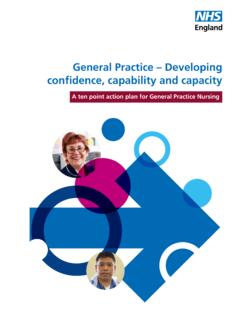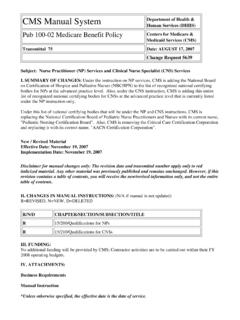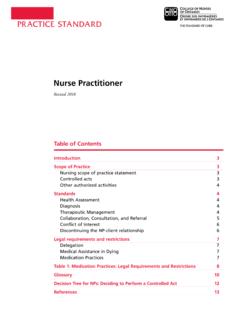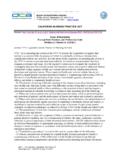Transcription of Nursing in General Practice - Australian College of Nursing
1 A guide for the General Practice teamNURSING IN General Practice ISBN: 978-0-9943105-3-8 Nursing in General Practice : A guide for the General Practice team published by Australian College of Nursing , Canberra, 2015 Australian College of Nursing 2015A guide for the General Practice teamNURSING IN General Practice AIMThis handbook has been developed to provide the General Practice team with information on employing and supporting registered and enrolled nurses in General Practice . The handbook has been developed by Australian College of Nursing with funding from the Australian Government Department of Health. It replaces the previous Nursing in General Practice Information Kit, first published in 2001 and revised in 2005 by Royal College of Nursing , Australia. The handbook has been updated to reflect the ongoing development of roles of nurses in General Practice , as well as changes to funding mechanisms available to support the employment of nurses in General Practice .
2 ACN would like to acknowledge with thanks the review group of nurses, nurse practitioners, General practitioners and Practice managers employed in General Practice who provided feedback on the handbook s accuracy and in General Practice : A guide for the General Practice teamCONTENTSSECTION 1: NURSES IN General Practice 3 nurse registration 4 What s the difference between the titles? 5 Nursing roles 6 Patient perceptions 7 SECTION 2: PROFESSIONAL ACCOUNTABILITY 9 Professional Practice 11 Clinical governance 12 SECTION 3: OPPORTUNITIES IN General Practice 15 Specialist Nursing services 16 nurse clinics 17 nurse practitioner services 18 SECTION 4: POSITIVE Practice ENVIRONMENTS 21 Collaborative Practice 22 Leadership 22 Evidence-based Practice and nurse -led research 22 Teaching 23 Mentoring 23 Wellbeing at work 23 Career progression 23 SECTION 5.
3 MAXIMISING Practice BENEFITS 25 Practice nurse Incentive Program (PNIP) payments 26 Coordinated Veterans Care Program 27 Medicare Benefits Schedule items for nurses 27 nurse practitioners 27 SECTION 6: HUMAN RESOURCES 29 Retention 30 Nurses salaries and conditions of employment 30 Performance reviews 31 EMPLOYER S CHECKLIST 32 RESOURCES 33 General resources 33 Professional Practice standards 34 CONTACTS 35 ACRONYMS 36 Nursing in General Practice : A guide for the General Practice team2 Nursing in General Practice : A guide for the General Practice team3 SECTION 1: NURSES IN General PRACTICEN urses are key members of multidisciplinary primary health care teams in General Practice .
4 A nurse s scope of Practice is determined by their registration (registered nurse or enrolled nurse ), endorsement ( nurse practitioner ), educational background, previous Nursing experience and clinical specialisation. Their roles may vary significantly between practices , generally reflecting local population health needs and complementing the services provided by the General Practice team. This section outlines the regulatory framework for Nursing , describes the differences between enrolled nurses, registered nurses and nurse practitioners and provides an overview of the diverse roles nurses in General Practice may undertake. 4 nurse registration Nurses and midwives must be registered with the Nursing and Midwifery Board of Australia (NMBA) in order to Practice in Australia.
5 A nurse will be registered as either a registered nurse or an enrolled nurse depending on their educational preparation. nurse practitioners are registered nurses who are educated and endorsed to Practice in an advanced and extended role. In addition to overseeing the registration process, the NMBA also develops standards, codes and guidelines for the Nursing and midwifery professions and investigates concerns about the professional conduct of nurses and midwives. The NMBA s functions are supported by the Australian Health practitioner Regulation Agency (AHPRA) whose operations are governed by the Health practitioner Regulation National Law (the National Law), as in force in each state and territory. A publicly available register of nurses who are registered to Practice in Australia is on AHPRA s standardsThere are five mandatory registration standards which all nurses must meet to be registered.
6 They are related to: criminal history English language skills professional indemnity insurance arrangements (see Section 2) continuing professional development (see Section 2) recency of Practice . Nurses must be able to meet the standards each year at the time of renewal of their registration. All Nursing registration standards can be viewed on the NMBA s may have one or more endorsements of their registration to identify additional qualifications and specific expertise. Standards exist that must be met by registered nurses to obtain and maintain these endorsements for registered nurses are: nurse practitioner registered nurse supply scheduled medicines (rural and isolated Practice ).NotationsBefore the National Registration and Accreditation Scheme was introduced, each state and territory used a different approach to the regulation of nurses with a sole qualification in mental health Nursing , paediatric Nursing or disability Nursing .
7 Nurses with a sole qualification in one of these areas now have a notation on their registration which limits their scope of Practice to a specific area of Practice . They have General registration but with a notation solely qualified in the area .Conditions on Nursing registration The NMBA may impose conditions on the registration of an individual nurse . Conditions restrict a nurse s Practice , for example by requiring a nurse to undertake a period of supervised Practice or to complete further education within a specified period of time. Conditions are published on the register until they are no longer required. Protected titles and unregistered health care workersA range of protected titles exist under the Health practitioner Regulation National Law (The National Law) that nurses and midwives may use depending on their registration and endorsement of registration.
8 They are: nurse registered nurse enrolled nurse nurse practitioner midwife midwife occasion General Practice teams may also include unregistered health care workers, using titles such as medical assistant , assistant in Nursing or Nursing assistant . These unregistered health care workers are not nurses, are not regulated by the NMBA and should not use any of the protected standardsThe Nursing and Midwifery Board of Australia (NMBA) publishes national standards for Practice for registered nurses, enrolled nurses and nurse practitioners. These are the core standards against which a nurse s competence to Practice is assessed to determine initial and ongoing eligibility for registration. National competency standards for the enrolled nurse National competency standards for the registered nurse nurse practitioner standards for practiceA further range of professional Practice standards exist to support a number of areas of specialty Nursing Practice (see the Resources section at the end of this handbook).
9 Specific to General Practice are the National Practice Standards for Nurses in General Practice . While these standards are not required for registration, they provide a framework that reflects Nursing Practice in the General Practice setting. The standards for Practice are also useful to inform the development of Nursing roles in General Practice and accompanying position 1: Nursing IN General PRACTICEN ursing in General Practice : A guide for the General Practice team5 What s the difference between the titles?Registered nursesRegistered nurses (RNs) provide evidence-based Nursing care from care planning to delivery and evaluation, within their scope of Practice . As members of multidisciplinary health care teams RNs can play a central role in organising and coordinating care, as well as providing education to patients.
10 They are responsible and accountable for the Nursing care they provide and for the delegated care provided by enrolled nurses under their direction and supervision. Since the early 1990s the requirement for registration as a RN has been a Bachelor of Nursing degree (or an approved post-graduate qualification). RNs who were educated before the early 1990s may have completed a hospital-based Certificate course or a Diploma of Applied Science in Nursing . Enrolled nursesAn enrolled nurse (EN) is legally required to work under the direction and supervision of an RN and is responsible for providing delegated Nursing care to patients within their scope of Practice . The core responsibilities of ENs include assisting the RN with the delivery of Nursing care and providing support and comfort to patients.




